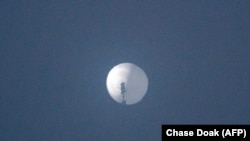What in the world is that thing?
The massive white orb drifting across U.S. airspace has triggered a diplomatic maelstrom and is blowing up on social media.
China insists the balloon is just an errant civilian airship used mainly for meteorological research that went off course due to winds and has only limited “self-steering” capabilities.
The United States says it is a Chinese spy balloon without a doubt. Its presence prompted Secretary of State Antony Blinken to cancel a weekend trip to China that was aimed at dialing down tensions that were already high between the countries.
The Pentagon says the balloon, which is carrying sensors and surveillance equipment, is maneuverable and has shown it can change course. It has loitered over sensitive areas of Montana where nuclear warheads are siloed, leading the military to take actions to prevent it from collecting intelligence.
A Pentagon spokesman said it could remain aloft over the U.S. for “a few days,” extending uncertainty about where it will go or if the U.S. will try to safely take it down. And late Friday, the Defense Department acknowledged reports of a balloon flying over Latin America — assessed as “another Chinese surveillance balloon.”
A look at what’s known about the balloon crossing the U.S. — and what isn’t.
IT'S A BIRD, IT'S A PLANE, IT'S A ... SPY BALLOON
The Pentagon and other U.S. officials say it's a Chinese spy balloon — about the size of three school buses — moving east over America at an altitude of about 60,000 feet (18,600 meters). The U.S. says it is being used for surveillance and intelligence collection, but officials have provided few details.
U.S. officials say the Biden administration was aware of it even before it crossed into American airspace in Alaska early this past week. A number of officials spoke on condition of anonymity to discuss the sensitive topic.
The White House said President Joe Biden was first briefed on the balloon on Tuesday. The State Department said Blinken and Deputy Secretary Wendy Sherman spoke with China's senior Washington-based official on Wednesday evening about the matter.
In the first public U.S. statement, Brig. Gen. Pat Ryder, the Pentagon press secretary, said Thursday evening that the balloon was not a military or physical threat — an acknowledgement that it was not carrying weapons. He said, "Once the balloon was detected, the U.S. government acted immediately to protect against the collection of sensitive information.”
Even if the balloon is not armed, it poses a risk to the U.S., said retired Army Gen. John Ferrari, a visiting fellow at the American Enterprise Institute. The flight itself, he said, can be used to test America's ability to detect incoming threats and to find holes in the country's air defense warning system. It may also allow the Chinese to sense electromagnetic emissions that higher-altitude satellites cannot detect, such as low-power radio frequencies that could help them understand how different U.S. weapons systems communicate.
He said the Chinese may have sent the balloon “to show us that they can do it, and maybe next time it could have a weapon. So, now we have to spend money and time on it” developing defenses.








